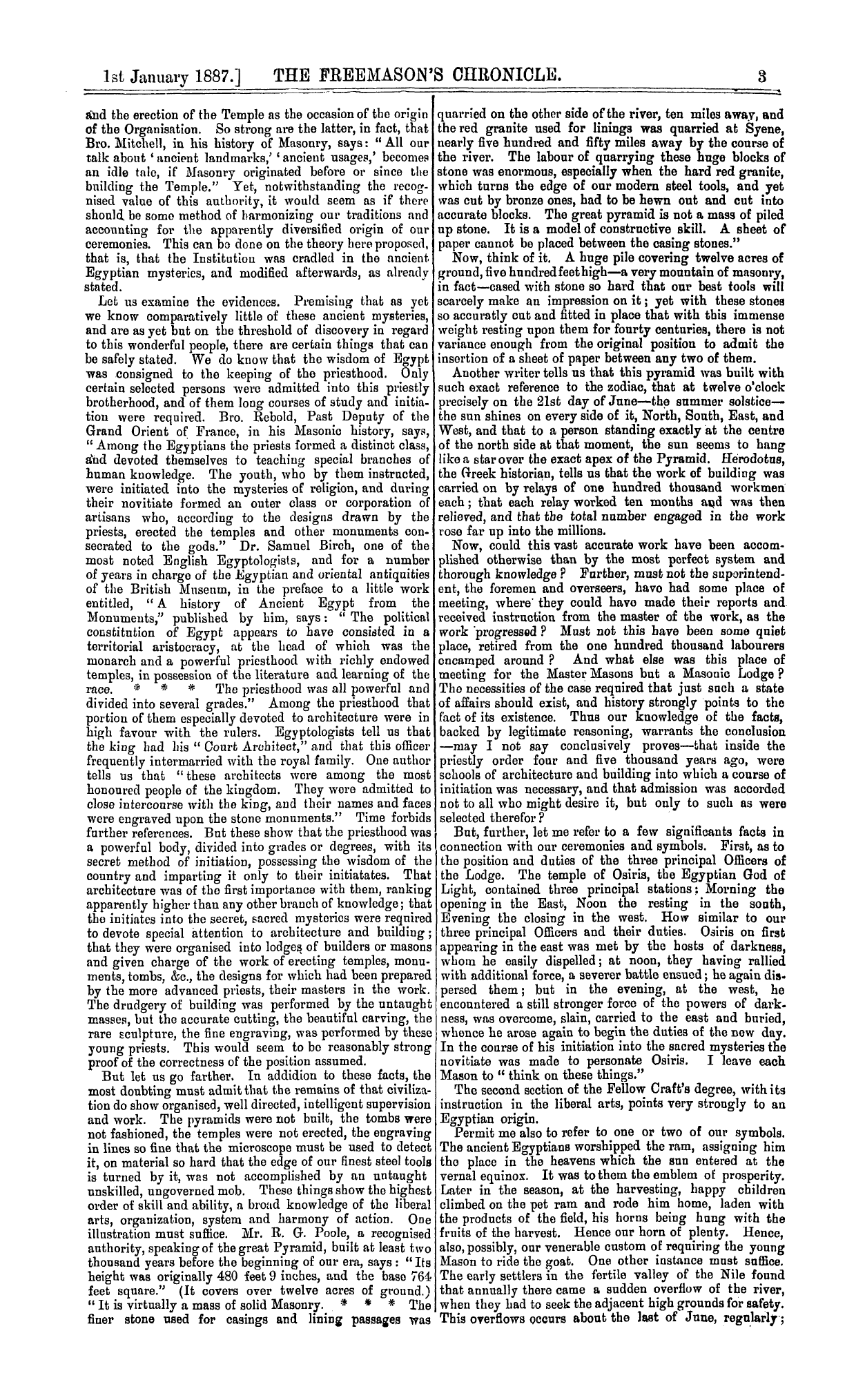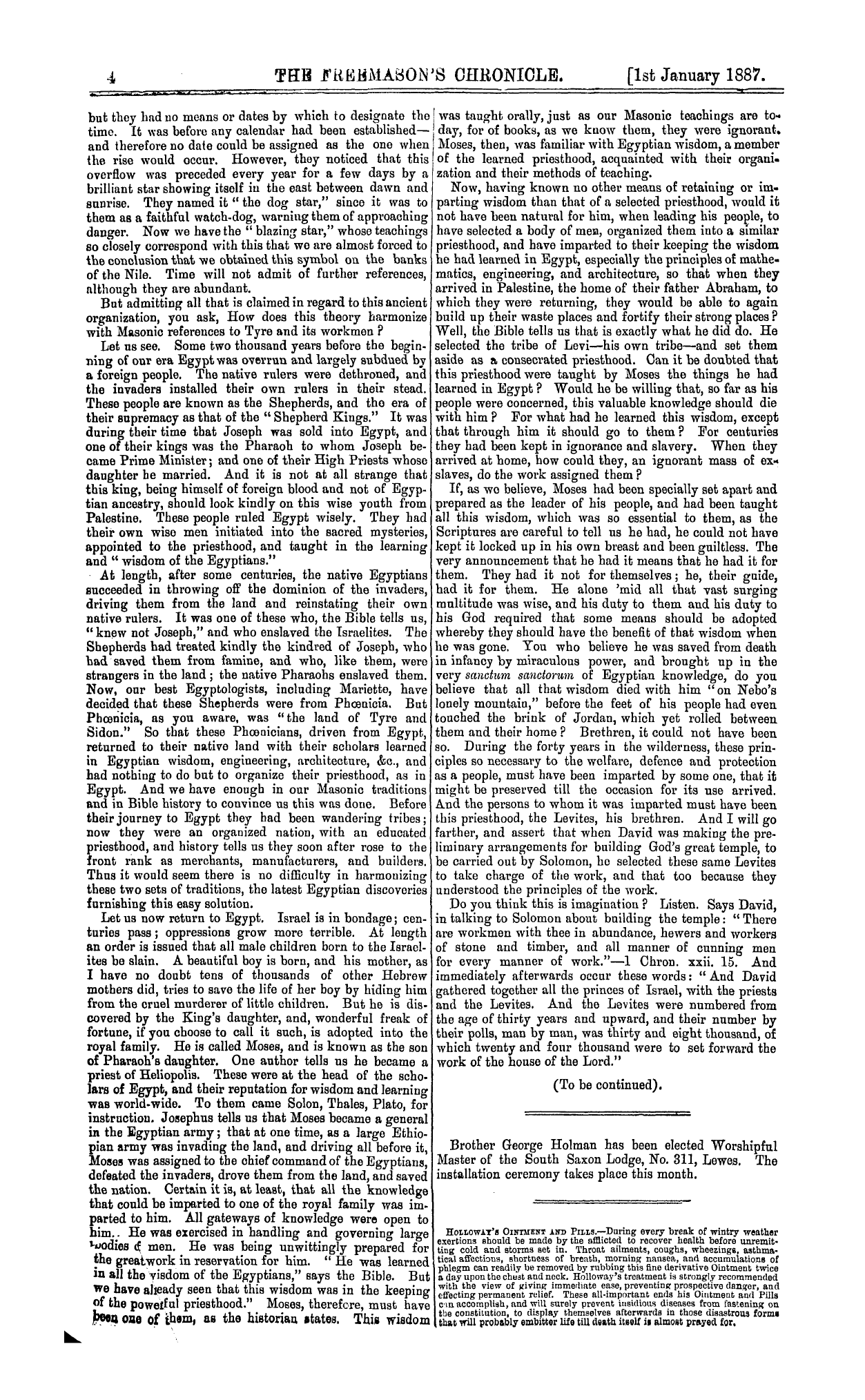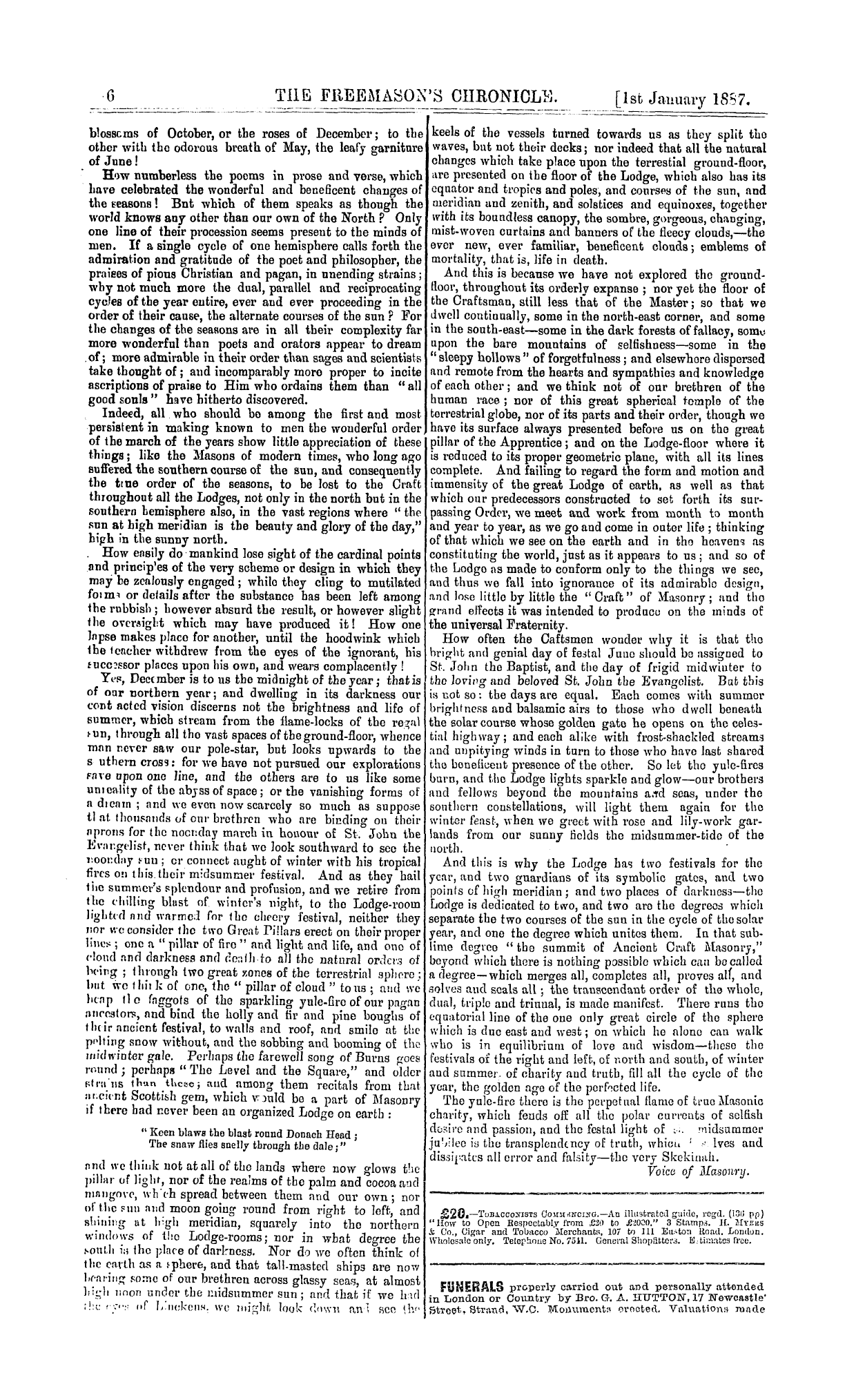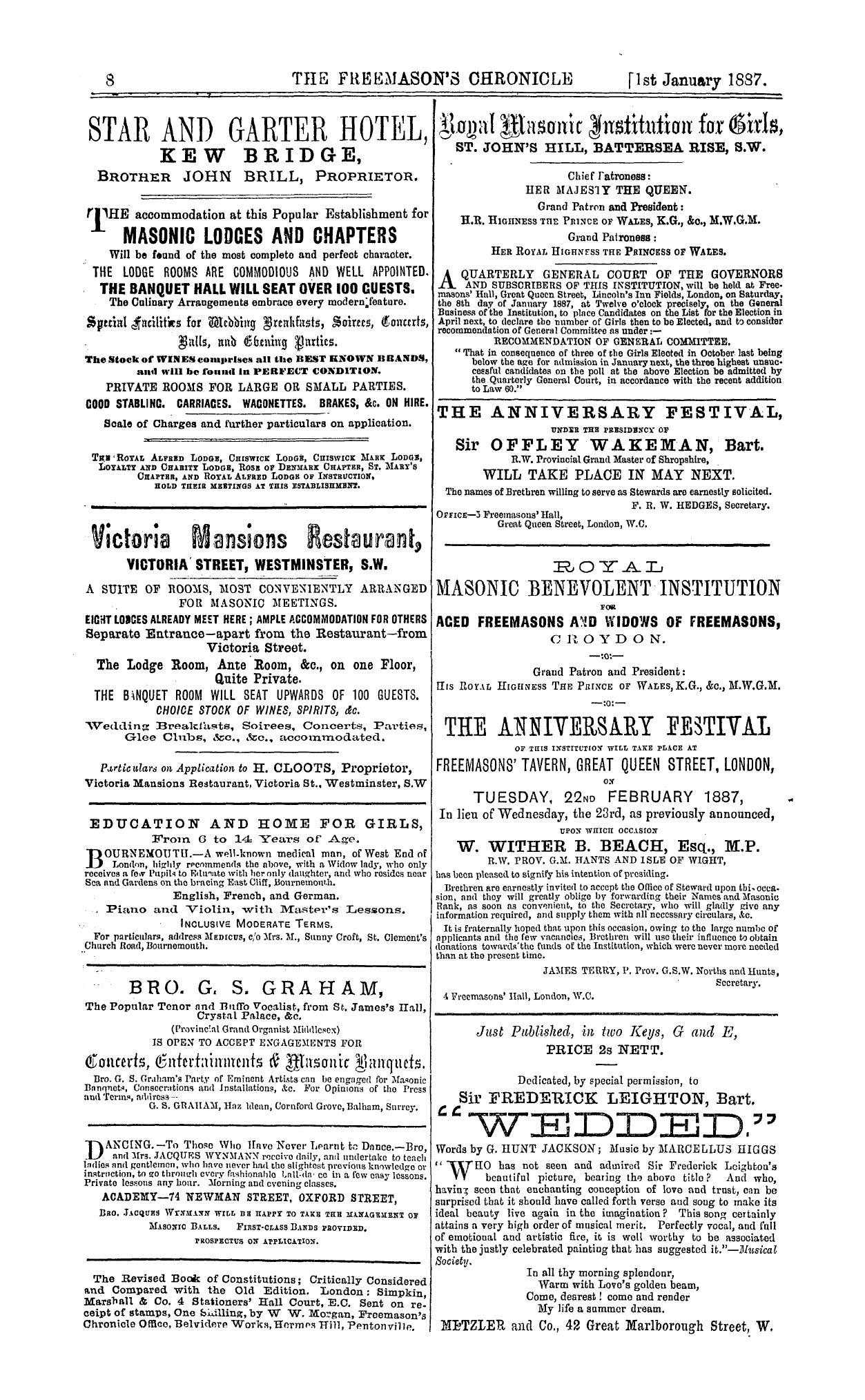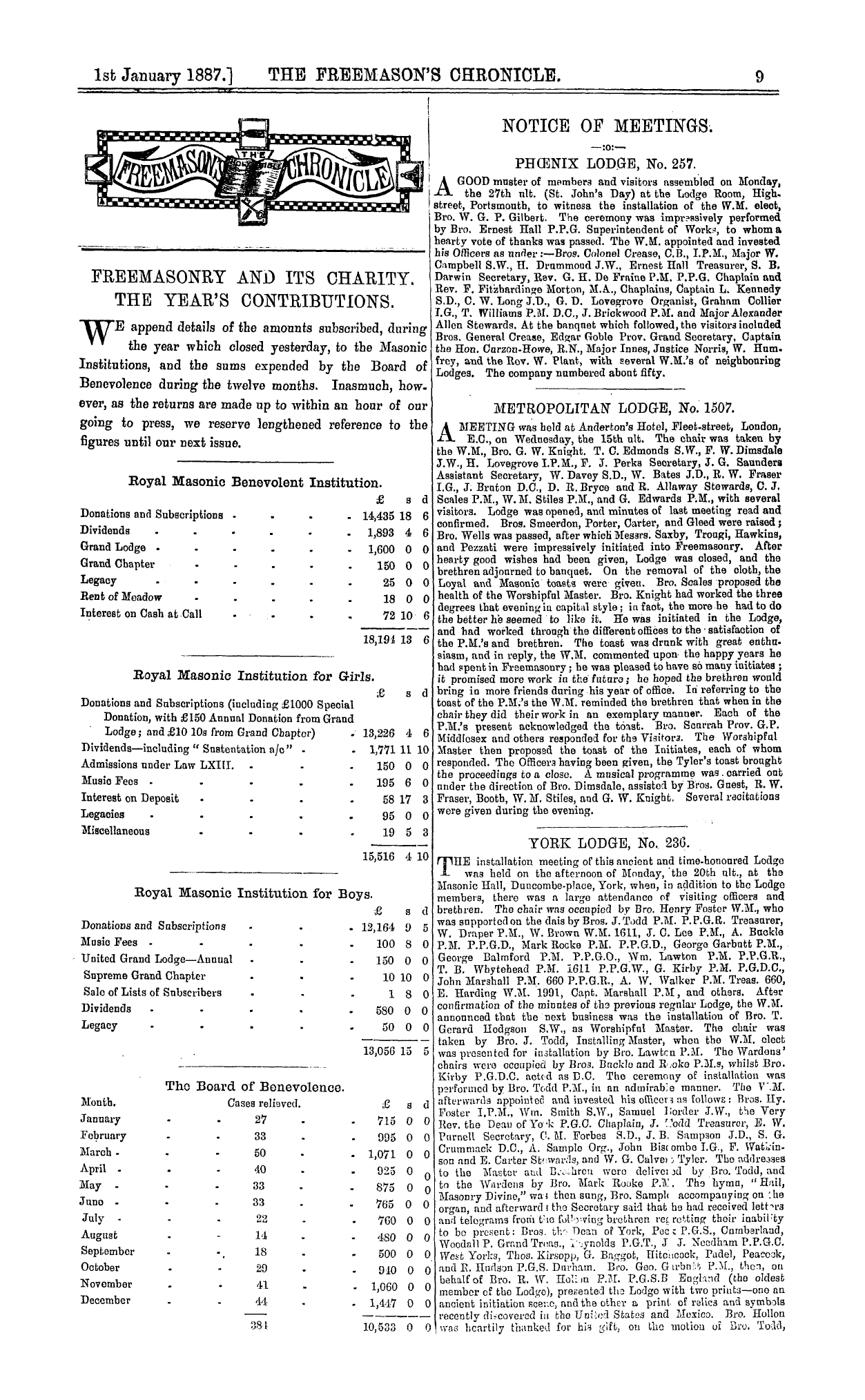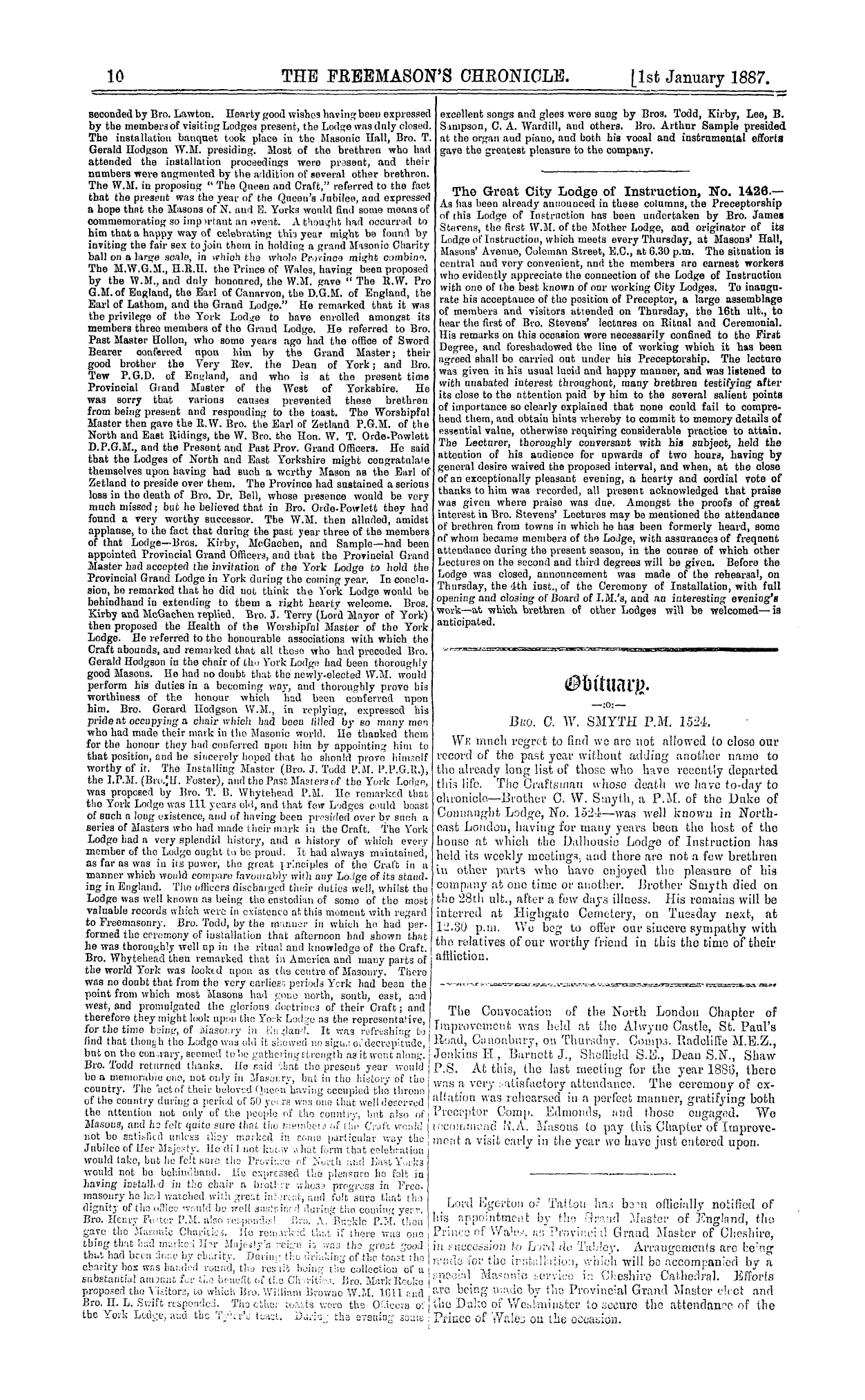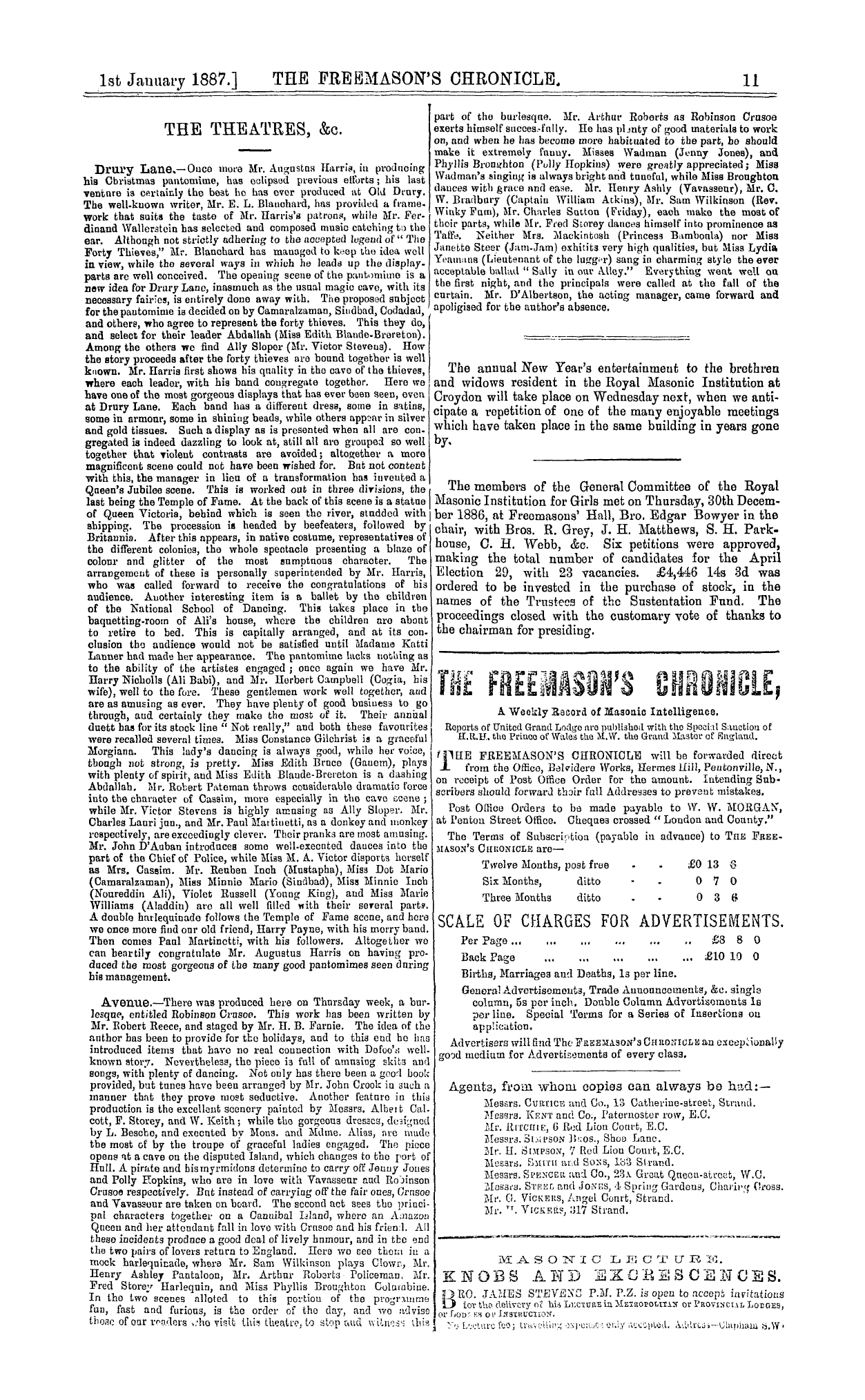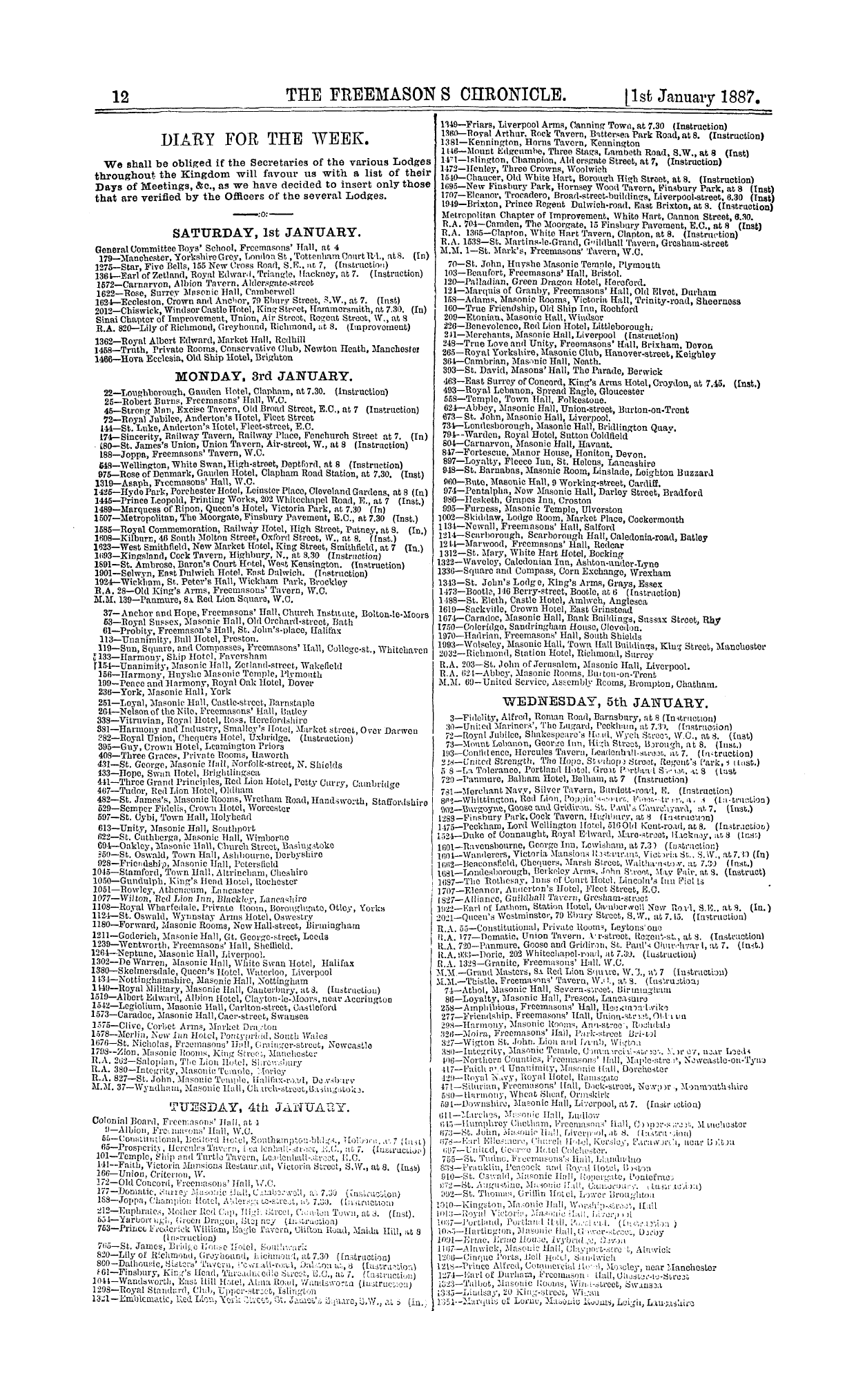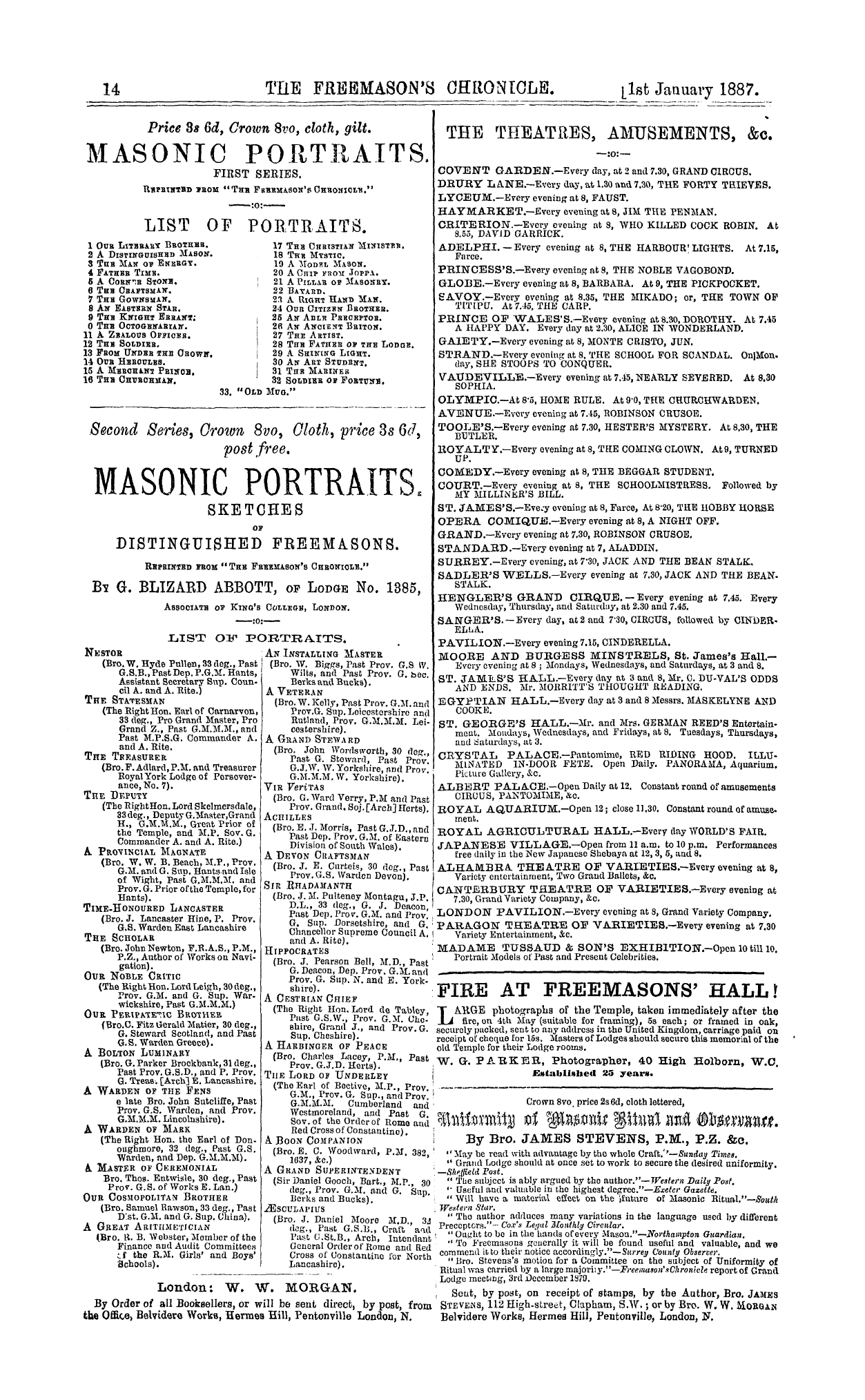-
Articles/Ads
Article WHENCE FREEMASONRY CAME. ← Page 2 of 3 Article WHENCE FREEMASONRY CAME. Page 2 of 3 →
Note: This text has been automatically extracted via Optical Character Recognition (OCR) software.
Whence Freemasonry Came.
and the erection of the Temple as the occasion of the origin of the Organisation . So strong are the latter , in fact , that Bro . Mitchell , in his history of Masonry , says : " All our talk about' ancient landmarks , ' ' ancient usages , ' becomes
an idle tale , if Masonry originated before or since the building the Temple . " Yet , notwithstanding the recognised value of this authority , it would seem as if there should be some method of harmonizing our traditions and
accounting for the apparently diversified origin of our ceremonies . This can be done on the theory here proposed , that is , that the Institution was cradled in the ancient Egyptian mysteries , and modified afterwards , as already stated .
Let us examine the evidences . Premising that as yet we know comparatively little of these ancient mysteries , and are as yet but on the threshold of discovery in regard to this wonderful people , there are certain things that can
be safely stated . We do know that the wisdom of Egypt was consigned to the keeping of the priesthood . Only certain selected persons were admitted into this priestly brotherhood , and of them long courses of study and
initiation were required . Bro . Rebold , Past Deputy of the Grand Orient of France , in his Masonic history , says , " Among the Egyptians the priests formed a distinct class , rind devoted themselves to teaching special branches of
human knowledge . The youth , who by them instructed , were initiated into the mysteries of religion , and during their novitiate formed an outer class or corporation of artisans who , according to the designs drawn by the
priests , erected the temples and other monuments consecrated to the gods . " Dr . Samuel Birch , one of the most noted English Egyptologists , and for a number of years in charge of the Egyptian and oriental antiquities
of the British Museum , in the preface to a little work entitled , " A history of Ancient Egypt from the Monuments , " published by him , says : " The political constitution of Egypt appears to have consisted in a
territorial aristocracy , at the head of which was the monarch and a powerful priesthood with richly endowed temples , in possession of the literature and learning of the race . * * * The priesthood was all powerful ancl
divided into several grades . " Among the priesthood that portion of them especially devoted to architecture were in high favour with the rulers . Egyptologists tell us that the king had his " Court Architect , " ancl that this officer
frequently intermarried with the royal family . One author tells us that " these architects were among the most honoured people of the kingdom . They were admitted to close intercourse with the king , and their names and faces
were engraved upon the stone monuments . " Time forbids further references . But these show that the priesthood was a powerful body , divided into grades or degrees , with its secret method of initiation , possessing the wisdom of the
country and imparting it only to their initiatates . That architecture was of the first importance with them , ranking apparently higher than any other branch of knowledge ; that the initiates into the secret , sacred mysteries were required
to devote special attention to architecture and building ; that they were organised into lodges of builders or masons and given charge of the work of erecting temples , monuments , tombs , & c , the designs for which had been prepared
by the more advanced priests , their masters in the work . The drudgery of building was performed by the untaught masses , but the accurate cutting , the beautiful carving , the
rare sculpture , the fine engraving , was performed by these young priests . This would seem to bo reasonably strong proof of the correctness of the position assumed .
But let us go farther . In addidion to these facts , the most doubting must admit that the remains of that civilization do show organised , well directed , intelligent supervision and work . The pyramids were not built , the tombs were
not fashioned , the temples were not erected , the engraving in lines so fine that the microscope must be used to detect it , on material so hard that the edge of our finest steel tools is turned by it , was not accomplished by an untaught
unskilled , ungoverned mob . These things show the highest order of skill and ability , a broad knowledge of the liberal arts , organization , system and harmony of action . One illustration must suffice . Mr . R . G . Poole , a recognised
authority , speaking of the great Pyramid , built afc least two thousand years before the beginning of our era , says : " Its height was originally 480 feefc 9 inches , and the base 764 feet square . " ( It covers over twelve acres of ground . ) " It is virtually a mass of solid Masonry . * * * The finer stone used for casings and lining passages was
Whence Freemasonry Came.
quarried on the other side of the river , ten miles away , and the red granite used for linings was quarried at Syene , nearly five hundred and fifty miles away by the course of the river . The labour of quarrying these huge blocks of stone was enormous , especially when the hard red granite , which turns the edge of our modern steel tools , and yet
was cut by bronze ones , had to be hewn ont and cut into accurate blocks . The great pyramid is nofc a mass of piled up stone . It is a model of constructive skill . A sheet of paper cannot be placed between the casing stones . " Now , think of it . A huge pile covering twelve acres of ground , five hundred feet high—a very mountain of masonry ,
in fact—cased with stone so hard thafc our best tools will scarcely make an impression on it ; yefc with these stones so accuratly cut and fitted in place that with this immense weight resting upon them for fourty centuries , there is not variance enough from the original position fco admit the insertion of a sheet of paper between any two of them .
Another writer tells ns that this pyramid was built with such exact reference to the zodiac , that afc twelve o ' clock precisely on the 21 sfc day of June—fche summer solsticethe sun shines on every side of it , North , South , East , and West , and that to a person standing exactly at the centre
of the north side at thafc moment , the sun seems to hang like a star over the exact apex of the Pyramid . Herodotus , the Greek historian , tells us that the work of building was carried on by relays of one hundred thousand workmen each ; thafc each relay worked ten months and was then relieved , and thafc tbe total number engaged in the work rose far up into the millions .
Now , could this vast accurate work have been accomplished otherwise than by the most perfect system and thorough knowledge ? Further , must not the superintendent , the foremen and overseers , havo had some place of meeting , where' they could havo made their reports and . received instruction from the master of the work , as the work progressed ? Must not this have been some quiet
place , retired from the one hundred thousand labourers encamped around ? And whafc else was this place of meeting for the Master Masons but a Masonic Lodge ? Tho necessities of the case required that just such a state of affairs should exist , aud history strongly points to the
fact of its existence . Thus our knowledge of the facts , backed by legitimate reasoning , warrants the conclusion —may I not say conclusively proves—that inside the priestly order four and five thousand years ago , were schools of architecture and building into which a course of initiation was necessary , and that admission was accorded not to all who might desire it , but only to such as were selected therefor ?
But , further , let me refer to a few significants facts in connection with our ceremonies and symbols . First , as to the position and duties of the three principal Officers of the Lodge . The temple of Osiris , the Egyptian God of
Light , contained three principal stations ; Morning the opening in the East , Noon the resting in the south , Evening the closing in the west . How similar to our three principal Officers and their duties . Osiris on first appearing in the east was met by the hosts of darkness ,
whom he easily dispelled ; at noon , they having rallied with additional force , a severer battle ensued ; he again dispersed them ; but in the evening , at the west , he
encountered a still stronger force of the powers of darkness , was overcome , slain , carried to the east and buried , whence he arose again to begin the duties of the new day . In the course of his initiation into the sacred mysteries the novitiate was made to personate Osiris . I leave each Mason to " think on these things . "
The second section of the Fellow Crafts degree , with its instruction in the liberal arts , points very strongly to an Egyptian origin .
Permit me also to refer to one or two of our symbols . The ancient Egyptians worshipped the ram , assigning him tho place in the heavens which the snn entered at the vernal equinox . It was to them the emblem o _ prosperity .
Later in the season , at the harvesting , happy children climbed on the pet ram and rode him home , laden with the products of the field , his horns being hang with the fruits of the harvest . Hence our horn of plenty . Hence ,
also , possibly , our venerable custom of requiring the young Mason to ride the goat . One other instance must suffice . The early settlers in the fertile valley of the Nile found that annually there came a sudden overflow of the river , when they had to seek the adjacent high grounds for safety . This overflows occurs about the last of June , regularly ;
Note: This text has been automatically extracted via Optical Character Recognition (OCR) software.
Whence Freemasonry Came.
and the erection of the Temple as the occasion of the origin of the Organisation . So strong are the latter , in fact , that Bro . Mitchell , in his history of Masonry , says : " All our talk about' ancient landmarks , ' ' ancient usages , ' becomes
an idle tale , if Masonry originated before or since the building the Temple . " Yet , notwithstanding the recognised value of this authority , it would seem as if there should be some method of harmonizing our traditions and
accounting for the apparently diversified origin of our ceremonies . This can be done on the theory here proposed , that is , that the Institution was cradled in the ancient Egyptian mysteries , and modified afterwards , as already stated .
Let us examine the evidences . Premising that as yet we know comparatively little of these ancient mysteries , and are as yet but on the threshold of discovery in regard to this wonderful people , there are certain things that can
be safely stated . We do know that the wisdom of Egypt was consigned to the keeping of the priesthood . Only certain selected persons were admitted into this priestly brotherhood , and of them long courses of study and
initiation were required . Bro . Rebold , Past Deputy of the Grand Orient of France , in his Masonic history , says , " Among the Egyptians the priests formed a distinct class , rind devoted themselves to teaching special branches of
human knowledge . The youth , who by them instructed , were initiated into the mysteries of religion , and during their novitiate formed an outer class or corporation of artisans who , according to the designs drawn by the
priests , erected the temples and other monuments consecrated to the gods . " Dr . Samuel Birch , one of the most noted English Egyptologists , and for a number of years in charge of the Egyptian and oriental antiquities
of the British Museum , in the preface to a little work entitled , " A history of Ancient Egypt from the Monuments , " published by him , says : " The political constitution of Egypt appears to have consisted in a
territorial aristocracy , at the head of which was the monarch and a powerful priesthood with richly endowed temples , in possession of the literature and learning of the race . * * * The priesthood was all powerful ancl
divided into several grades . " Among the priesthood that portion of them especially devoted to architecture were in high favour with the rulers . Egyptologists tell us that the king had his " Court Architect , " ancl that this officer
frequently intermarried with the royal family . One author tells us that " these architects were among the most honoured people of the kingdom . They were admitted to close intercourse with the king , and their names and faces
were engraved upon the stone monuments . " Time forbids further references . But these show that the priesthood was a powerful body , divided into grades or degrees , with its secret method of initiation , possessing the wisdom of the
country and imparting it only to their initiatates . That architecture was of the first importance with them , ranking apparently higher than any other branch of knowledge ; that the initiates into the secret , sacred mysteries were required
to devote special attention to architecture and building ; that they were organised into lodges of builders or masons and given charge of the work of erecting temples , monuments , tombs , & c , the designs for which had been prepared
by the more advanced priests , their masters in the work . The drudgery of building was performed by the untaught masses , but the accurate cutting , the beautiful carving , the
rare sculpture , the fine engraving , was performed by these young priests . This would seem to bo reasonably strong proof of the correctness of the position assumed .
But let us go farther . In addidion to these facts , the most doubting must admit that the remains of that civilization do show organised , well directed , intelligent supervision and work . The pyramids were not built , the tombs were
not fashioned , the temples were not erected , the engraving in lines so fine that the microscope must be used to detect it , on material so hard that the edge of our finest steel tools is turned by it , was not accomplished by an untaught
unskilled , ungoverned mob . These things show the highest order of skill and ability , a broad knowledge of the liberal arts , organization , system and harmony of action . One illustration must suffice . Mr . R . G . Poole , a recognised
authority , speaking of the great Pyramid , built afc least two thousand years before the beginning of our era , says : " Its height was originally 480 feefc 9 inches , and the base 764 feet square . " ( It covers over twelve acres of ground . ) " It is virtually a mass of solid Masonry . * * * The finer stone used for casings and lining passages was
Whence Freemasonry Came.
quarried on the other side of the river , ten miles away , and the red granite used for linings was quarried at Syene , nearly five hundred and fifty miles away by the course of the river . The labour of quarrying these huge blocks of stone was enormous , especially when the hard red granite , which turns the edge of our modern steel tools , and yet
was cut by bronze ones , had to be hewn ont and cut into accurate blocks . The great pyramid is nofc a mass of piled up stone . It is a model of constructive skill . A sheet of paper cannot be placed between the casing stones . " Now , think of it . A huge pile covering twelve acres of ground , five hundred feet high—a very mountain of masonry ,
in fact—cased with stone so hard thafc our best tools will scarcely make an impression on it ; yefc with these stones so accuratly cut and fitted in place that with this immense weight resting upon them for fourty centuries , there is not variance enough from the original position fco admit the insertion of a sheet of paper between any two of them .
Another writer tells ns that this pyramid was built with such exact reference to the zodiac , that afc twelve o ' clock precisely on the 21 sfc day of June—fche summer solsticethe sun shines on every side of it , North , South , East , and West , and that to a person standing exactly at the centre
of the north side at thafc moment , the sun seems to hang like a star over the exact apex of the Pyramid . Herodotus , the Greek historian , tells us that the work of building was carried on by relays of one hundred thousand workmen each ; thafc each relay worked ten months and was then relieved , and thafc tbe total number engaged in the work rose far up into the millions .
Now , could this vast accurate work have been accomplished otherwise than by the most perfect system and thorough knowledge ? Further , must not the superintendent , the foremen and overseers , havo had some place of meeting , where' they could havo made their reports and . received instruction from the master of the work , as the work progressed ? Must not this have been some quiet
place , retired from the one hundred thousand labourers encamped around ? And whafc else was this place of meeting for the Master Masons but a Masonic Lodge ? Tho necessities of the case required that just such a state of affairs should exist , aud history strongly points to the
fact of its existence . Thus our knowledge of the facts , backed by legitimate reasoning , warrants the conclusion —may I not say conclusively proves—that inside the priestly order four and five thousand years ago , were schools of architecture and building into which a course of initiation was necessary , and that admission was accorded not to all who might desire it , but only to such as were selected therefor ?
But , further , let me refer to a few significants facts in connection with our ceremonies and symbols . First , as to the position and duties of the three principal Officers of the Lodge . The temple of Osiris , the Egyptian God of
Light , contained three principal stations ; Morning the opening in the East , Noon the resting in the south , Evening the closing in the west . How similar to our three principal Officers and their duties . Osiris on first appearing in the east was met by the hosts of darkness ,
whom he easily dispelled ; at noon , they having rallied with additional force , a severer battle ensued ; he again dispersed them ; but in the evening , at the west , he
encountered a still stronger force of the powers of darkness , was overcome , slain , carried to the east and buried , whence he arose again to begin the duties of the new day . In the course of his initiation into the sacred mysteries the novitiate was made to personate Osiris . I leave each Mason to " think on these things . "
The second section of the Fellow Crafts degree , with its instruction in the liberal arts , points very strongly to an Egyptian origin .
Permit me also to refer to one or two of our symbols . The ancient Egyptians worshipped the ram , assigning him tho place in the heavens which the snn entered at the vernal equinox . It was to them the emblem o _ prosperity .
Later in the season , at the harvesting , happy children climbed on the pet ram and rode him home , laden with the products of the field , his horns being hang with the fruits of the harvest . Hence our horn of plenty . Hence ,
also , possibly , our venerable custom of requiring the young Mason to ride the goat . One other instance must suffice . The early settlers in the fertile valley of the Nile found that annually there came a sudden overflow of the river , when they had to seek the adjacent high grounds for safety . This overflows occurs about the last of June , regularly ;


